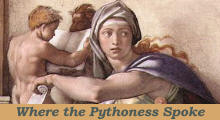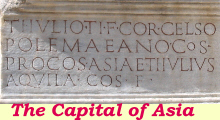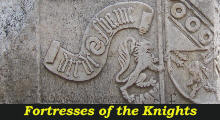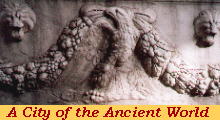

What's New!
Detailed Sitemap
All images © by Roberto Piperno, owner of the domain. Write to romapip@quipo.it. Text edited by Rosamie Moore.
Page added in October 2007.
|

 - The Oracle of Delphi - page two - The Oracle of Delphi - page two
(Sistine Chapel in Rome: Sibilla Delphica by Michelangelo)
Delphi acquired such an importance that the Greek town-states set aside their rivalries and agreed
on establishing a joint management (Amphictyonic League) of the Oracle; a council of 24 members representing 12 town-states presided over the administration of the territory belonging to Delphi and
over the arrangements for the Pythian Games.
The olive sea
The territory belonging to Delphi included the valley of the River Pleistos from its source at Mount Parnassos to its mouth in the Corinthian Gulf.
Today the lower part of the valley and the coastal plain are an immense olive-grove which seen from Delphi resembles a green sea.
Kira: site of the ancient harbour
Most of the pilgrims (and Apollo too) reached Delphi by sea: they landed at Kira (next to the modern town of Itea) on the Corinthian Gulf; the distance between Kira and Delphi is just 10 miles and
this meant that the inhabitants of Peloponnese and of Corinth had a pretty easy access to the Oracle; a road along the southern flank of Mount Parnassos linked Delphi with Thebes.
Treasure of Sifnos: reliefs portraying events of the Trojan War
The Greek town-states competed in embellishing Delphi with works of art; archaeologists believe that they were not made on the site, but they were commissioned to sculptors living in the main towns and then shipped to Delphi;
this is most likely the case for the fine reliefs which decorated the Treasure of Sifnos.
The government of this small and very rich island decorated its Treasure with reliefs celebrating the Greek victory in the Trojan War. The marble of the reliefs came from Paros.
Treasure of Athens: (left) Theseus; (right) Heracles
While the inhabitants of Sifnos chose to portray events which were common to all Greeks, those of Athens preferred to celebrate Theseus,
the legendary founder of their city and to associate him with Heracles, the most famous divine hero of Greek mythology.
Sphinx of Nassos, Kouroi of Argos and Omphalos of Athens
The works of art decorating Delphi were not limited to reliefs: not all Greek town-states had a Treasure yet they wanted to be present in Delphi, so there were many columns supporting statues, such as the Sphinx sent by Nassos.
A favourable prediction which turned true prompted a votive offering such as the kouroi sent by Argos: these male nude statues were ideals depictions of Apollo.
Greek mythology has often more than one account about a certain event. An alternative version to the founding of Delphi, because of
the intervention by Apollo, was attributed to Zeus. He sent eagles from the two ends of the world to meet at its centre: they met on the
Fedriades: so Delphi was regarded as the omphalos (navel) of the world and in the area near the sanctuary several conic navel-stones have been found:
one of them is covered by the agrenon, a kind of thick net: a reference to how Zeus was saved by his mother Rhea: she deceived Chronus by giving him a stone wrapped in cloth to swallow, rather than their baby.
Frieze of the tholos and a kylix portraying Apollo
The surviving reliefs of the tholos, the circular temple on the site of the ancient shrine have been placed in a partially reconstructed frieze; minor votive offerings included ceramics: the decoration of a kylix (a broad wine-drinking cup)
is very interesting because it shows Apollo wearing a peplum and a himation, both female garments; an indication that the worship of Apollo retained some aspects of the previous cult of Gaia.
Roman reliefs: (left) Romans defeating the Macedonians; (right) a labour of Hercules
With the decline of the Greek town-states, Delphi fell under the influence of the kings of Macedonia: in 168 BC Perseus, the last king, in the third Macedonian War was defeated at Pidna by the Roman consul Lucius Aemilius Paulus;
the Romans had already extended ther influence over Greece in 196, but they preferred to appear as liberators of Greece from the Macedonians. Aemilius Paulus ordered that a pillar, intended to be used to support a golden statue of Perseus, be used instead to celebrate his victory at Pidna: in the reliefs the Macedonians were identified by studded round shields, the Romans by oblong ones.
During the Roman period the Oracle continued to enjoy a great reputation: Cicero followed the advice received at Delphi and abandoned his political career to pursue his oratory skills and earn the fame he was seeking.
The emperors promoted restorations and embellishments including that of the theatre which was decorated with reliefs showing the labours of Hercules.
The growth of new beliefs in the IIIrd century AD led to the decline of the Oracle; at the beginning of the IVth century Emperor Constantine did not mind irritating Apollo by removing a sacred tripod to the Hippodrome of Constantinople.
In the second half of the
IVth century the Oracle was almost mute; according to tradition the following was its last prediction:
... the fair wrought house has fallen.
No shelter has Apollo, nor sacred laurel leaves;
The fountains are now silent; the voice is stilled.
It is finished.
Statues: (left to right) Agias, winner of the pancration
contest (a mix of boxing and wrestling) at the Olympic and Pythian Games; Antinous, the lover of Emperor Hadrian; the Charioteer, the winner of the chariot race at the Pythian Games
The extensive excavations carried out towards the end of the XIXth century by French
archaeologists were rewarded by the finding of some very fine statues; the statue of Agias was a contemporary marble copy of a bronze by Lysippos, one of the great sculptors of Classical Greece.
The statue of Antinous is among the finest ones commissioned by Hadrian: the face was polished and greased to enhance its whiteness and it makes an extraordinary contrast with the reddish colour of the hair.
The bronze statue of the Charioteer is regarded as the masterpiece of the early Greek Classical period:
it is a very intriguing statue: it celebrated Polyzalos, tyrant of Gela, a Greek town in southern Sicily, who won the chariot race at the Pythian games; fragments of four bronze horses were found during the excavations; they were assumed to be part of the whole monument;
however the young man portrayed in the statue is not supposed to be Polyzalos, but a charioteer employed by him; the artist who cast the statue in separate pieces was extremely talented and skilled in the rendering of the garment, of the hair, of the feet; the fact that he portrayed the charioteer in such a rigid pose,
that he inclined the head to one side, that he gave the young man a staring look and a modest demeanour, have led some scholars to believe that the Charioteer was not alone and that a statue of Polyzalos stood on its left.
* * *
Move to page one to see the archaeological site.
Clickable Map of the Ionian and Aegean Seas with links to other locations covered in this website (opens in a separate window)

SEE THESE OTHER EXHIBITIONS (for a full list see my detailed index).
  
|